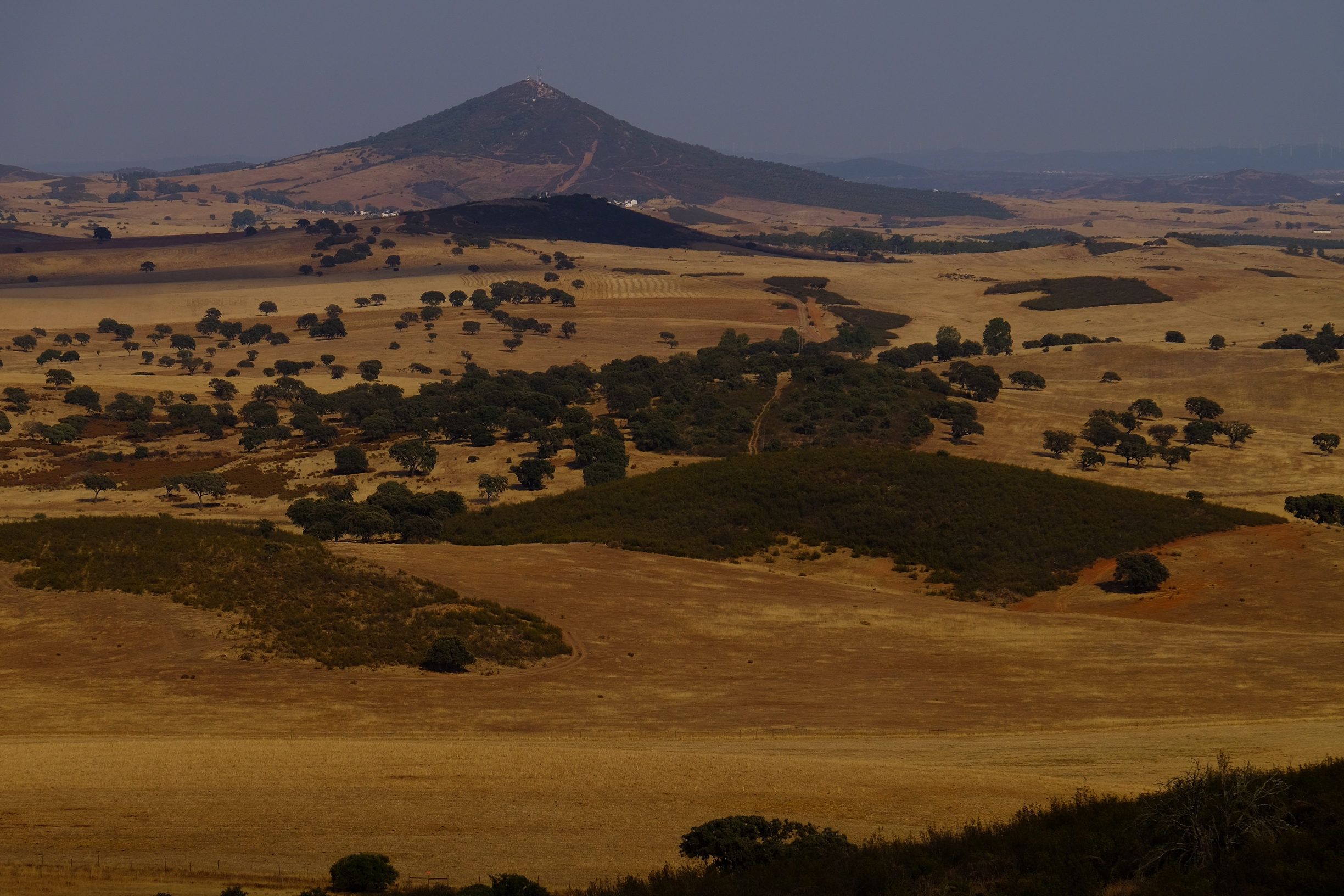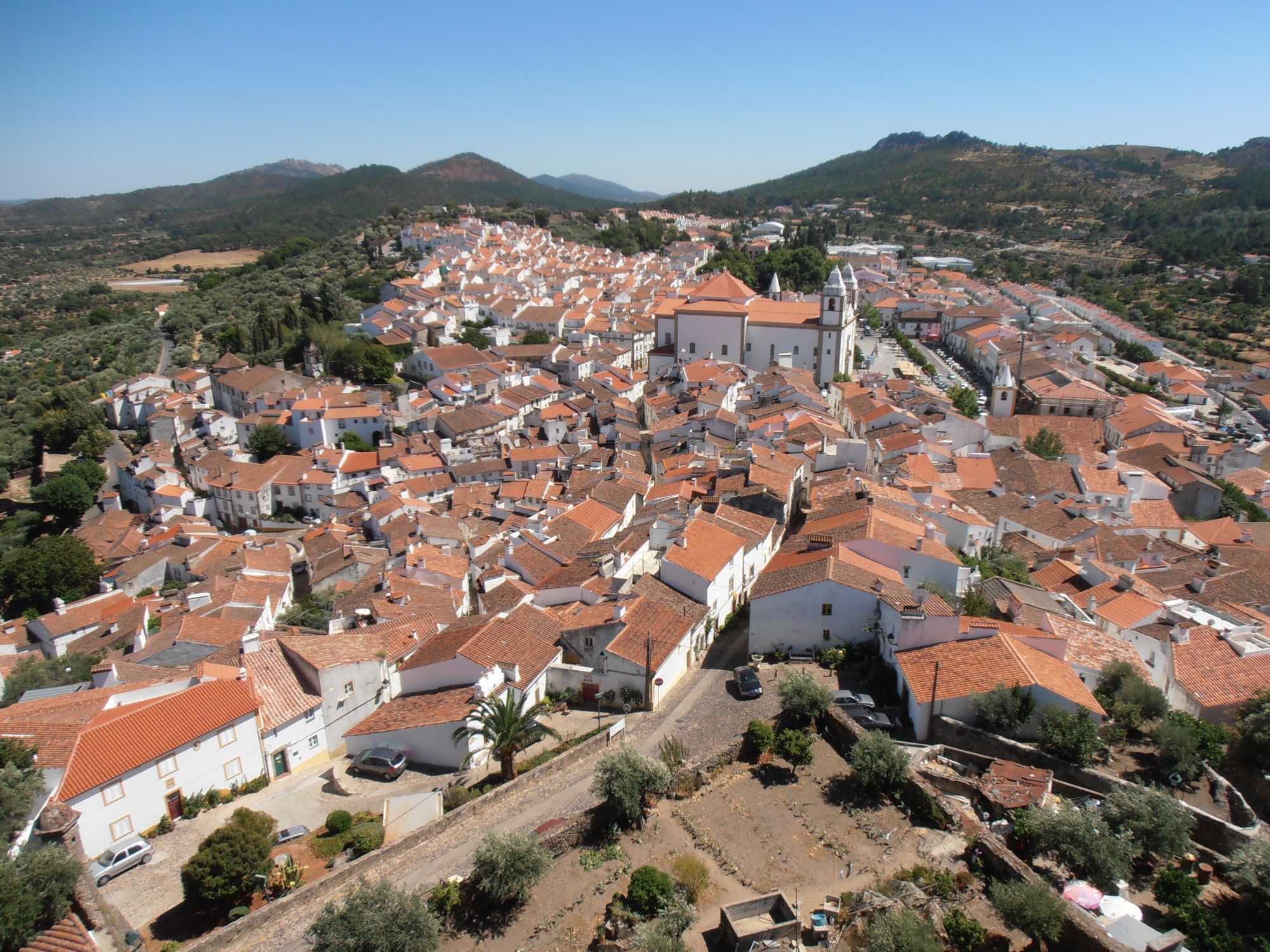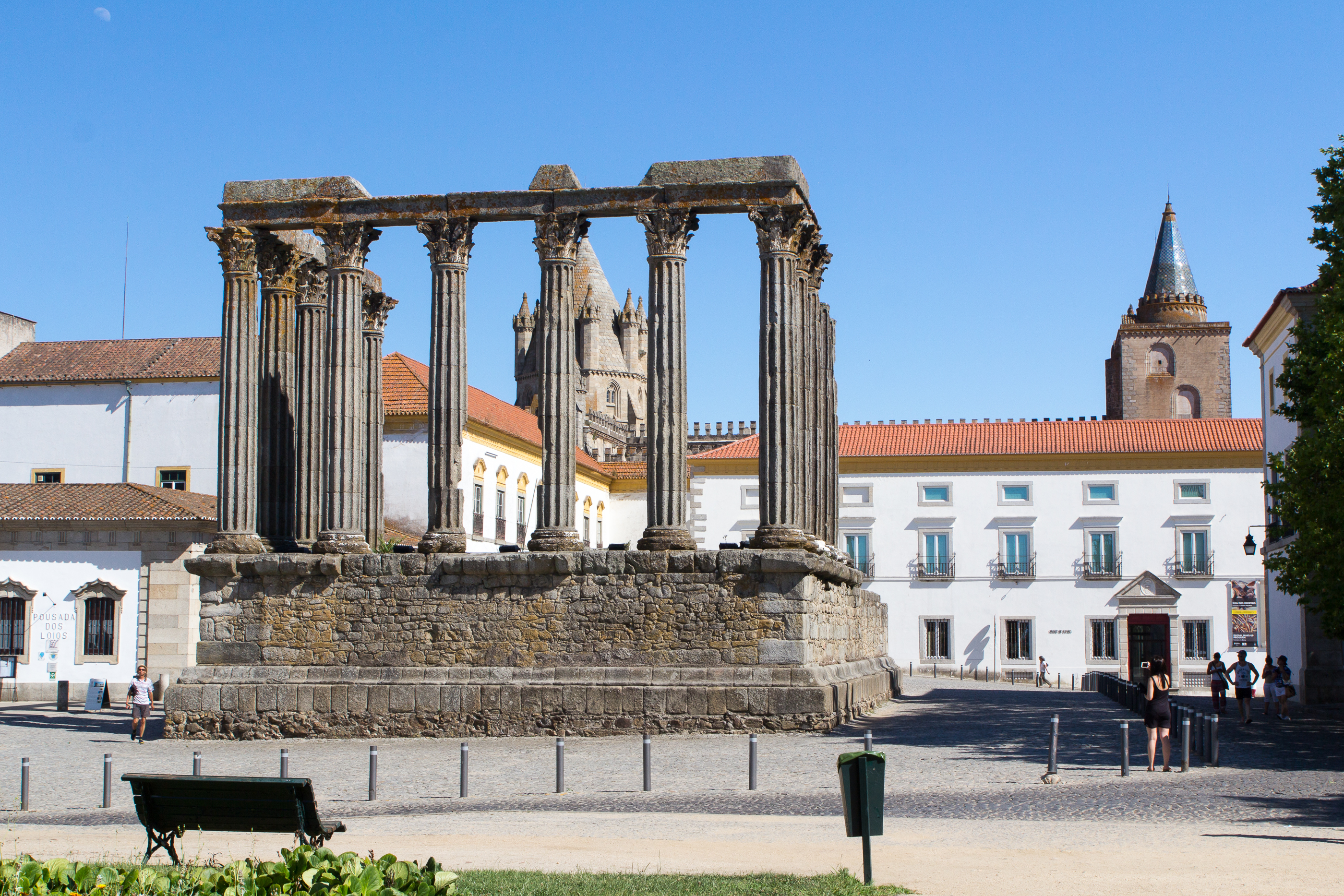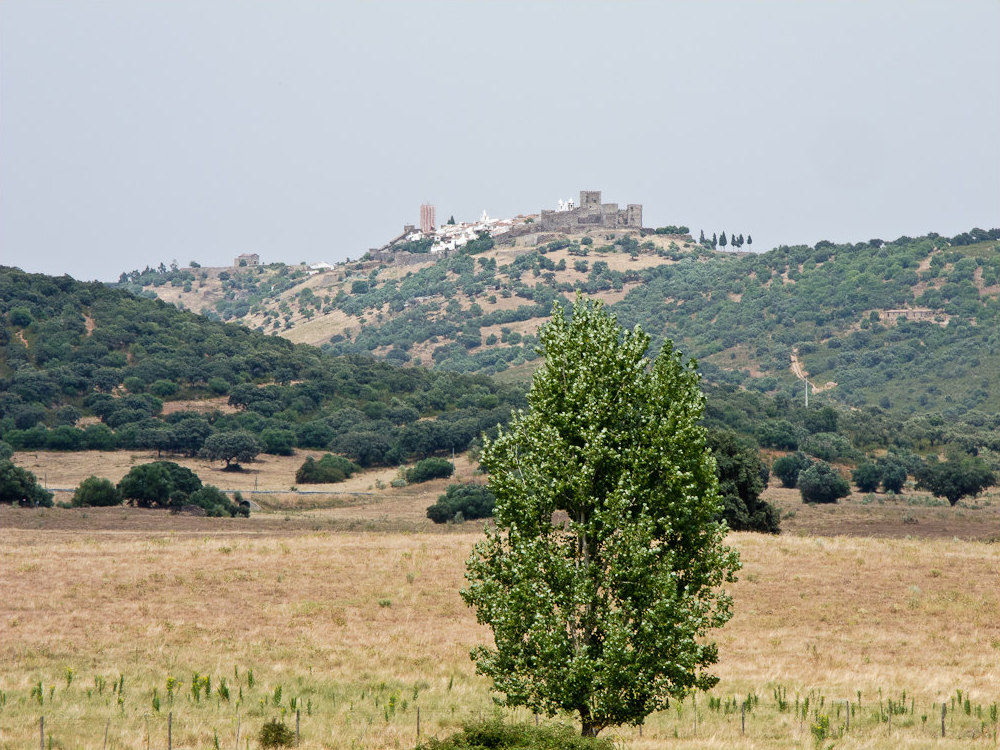Alentejo on:
[Wikipedia]
[Google]
[Amazon]
Alentejo ( , ) is a geographical, historical, and cultural region of south–central and southern

 Topographically, the countryside varies from the open rolling plains of the south of Alentejo to the granite hills that border Spain in the northeast. To feed the water needs of this considerable area, a number of public dams have been constructed, most notably the
Topographically, the countryside varies from the open rolling plains of the south of Alentejo to the granite hills that border Spain in the northeast. To feed the water needs of this considerable area, a number of public dams have been constructed, most notably the 


 The area is commonly known as the "breadbasket" of Portugal, a region of vast open countryside with undulating plains and rich fertile soil. With very few exceptions, all the major towns are mainly reliant on agriculture, livestock, and forestry. There are several types of traditional cheeses, wines, and smoked hams and sausages made in the Alentejo region, including ''Queijo Serpa'', ''Queijo de Évora'', and '' Queijo de Nisa'' ( PDO cheeses); '' Vinho do Alentejo'' and '' Vinho do Redondo'' (wines); and
The area is commonly known as the "breadbasket" of Portugal, a region of vast open countryside with undulating plains and rich fertile soil. With very few exceptions, all the major towns are mainly reliant on agriculture, livestock, and forestry. There are several types of traditional cheeses, wines, and smoked hams and sausages made in the Alentejo region, including ''Queijo Serpa'', ''Queijo de Évora'', and '' Queijo de Nisa'' ( PDO cheeses); '' Vinho do Alentejo'' and '' Vinho do Redondo'' (wines); and  The region is home to the world's most important area for the growing of
The region is home to the world's most important area for the growing of
Melhor Alentejo
Visit Alentejo
* * {{Authority control Regions of Portugal
Portugal
Portugal, officially the Portuguese Republic ( pt, República Portuguesa, links=yes ), is a country whose mainland is located on the Iberian Peninsula of Southwestern Europe, and whose territory also includes the Atlantic archipelagos of ...
. In Portuguese, its name means "beyond () the Tagus river
The Tagus ( ; es, Tajo ; pt, Tejo ; see below) is the longest river in the Iberian Peninsula. The river rises in the Montes Universales near Teruel, in mid-eastern Spain, flows , generally west with two main south-westward sections, to ...
" (''Tejo'').
Alentejo includes the regions of Alto Alentejo and Baixo Alentejo. It corresponds to the districts of Beja, Évora
Évora ( , ) is a city and a municipality in Portugal. It has 53,591 inhabitants (2021), in an area of 1307.08 km2. It is the historic capital of the Alentejo and serves as the seat of the Évora District.
Due to its well-preserved old ...
, Portalegre, and Alentejo Litoral
The Comunidade Intermunicipal do Alentejo Litoral () is an administrative division in Portugal. It was created in May 2009. It is also a NUTS3 subregion of the Alentejo Region.Évora
Évora ( , ) is a city and a municipality in Portugal. It has 53,591 inhabitants (2021), in an area of 1307.08 km2. It is the historic capital of the Alentejo and serves as the seat of the Évora District.
Due to its well-preserved old ...
, Beja, Sines
Sines () is a city and a municipality in Portugal. The municipality, divided into two parishes, has around 14,214 inhabitants (2021) in an area of . Sines holds an important oil refinery and several petrochemical industries. It is also a popular ...
, Serpa
Serpa () is a city and a Concelho (municipality) in the central Portuguese region Alentejo. The population in 2011 was 15,623, in an area of . The Guadiana River flows close to the town of Serpa.
History
Serpa has its origins in early settle ...
, Estremoz
Estremoz () is a municipality in Portugal. The population in 2011 was 14,318, in an area of 513.80 km². The city Estremoz itself had a population of 7,682 in 2001. It is located in the Alentejo region.
History
The region around Estremoz ...
, Elvas
Elvas () is a Portuguese municipality, former episcopal city and frontier fortress of easternmost central Portugal, located in the district of Portalegre in Alentejo. It is situated about east of Lisbon, and about west of the Spanish fortress ...
, and Portalegre.
It has borders with Beira Baixa in the north, with Spain (Andalucia
Andalusia (, ; es, Andalucía ) is the southernmost autonomous community in Peninsular Spain. It is the most populous and the second-largest autonomous community in the country. It is officially recognised as a "historical nationality". The t ...
and Extremadura
Extremadura (; ext, Estremaúra; pt, Estremadura; Fala: ''Extremaúra'') is an autonomous community of Spain. Its capital city is Mérida, and its largest city is Badajoz. Located in the central-western part of the Iberian Peninsula, it ...
) in the east, Algarve
The Algarve (, , ; from ) is the southernmost NUTS II region of continental Portugal. It has an area of with 467,495 permanent inhabitants and incorporates 16 municipalities ( ''concelhos'' or ''municípios'' in Portuguese).
The region has it ...
in the south, and the Atlantic Ocean, Ribatejo
The Ribatejo () is the most central of the traditional provinces of Portugal, with no coastline or border with Spain. The region is crossed by the Tagus river (''Ribatejo'' translates to "upper Tagus", or more precisely, "up the Tagus" relativ ...
, and Estremadura in the west.
Alentejo is a region known for its traditional polyphonic singing groups, similar to those found in Tuscany
Tuscany ( ; it, Toscana ) is a Regions of Italy, region in central Italy with an area of about and a population of about 3.8 million inhabitants. The regional capital is Florence (''Firenze'').
Tuscany is known for its landscapes, history, art ...
, Corsica
Corsica ( , Upper , Southern ; it, Corsica; ; french: Corse ; lij, Còrsega; sc, Còssiga) is an island in the Mediterranean Sea and one of the 18 regions of France. It is the fourth-largest island in the Mediterranean and lies southeast of ...
, and elsewhere.
History
Thecomarca
A ''comarca'' (, or , or ) is a traditional region or local administrative division found in Portugal, Spain and some of their former colonies, like Brazil, Nicaragua, and Panama. The term is derived from the term ''marca'', meaning a "march, ...
of the Alentejo became the Alentejo Province, divided into upper (Alto Alentejo Province
Alto Alentejo was a Portuguese province. It was abolished with the Constitution of 1976.
The area is now covered by Alto Alentejo Subregion and Alentejo Central Subregion.
Municipalities
* Alandroal Municipality
* Alter do Chão Municipality
...
) and lower (Baixo Alentejo Province
Baixo Alentejo was a Portuguese province. It was abolished with the Constitution of 1976.
Districts
* Beja District
* Setúbal District (southern half)
Subregions
The area is equal to the area covered by Baixo Alentejo Subregion
The ...
) designations. The modern NUTS statistical region, Alentejo Region
Alentejo Region () is one of the seven NUTS 2 regions of Portugal. It covers all of the historical Alentejo Province and part of the historical Ribatejo and Estremadura provinces.
The greater region is defined within Portugal by the land bo ...
, was expropriated from the medieval provinces and historical territories of Estremadura Province (specifically the 1936 portions of the Ribatejo
The Ribatejo () is the most central of the traditional provinces of Portugal, with no coastline or border with Spain. The region is crossed by the Tagus river (''Ribatejo'' translates to "upper Tagus", or more precisely, "up the Tagus" relativ ...
).
The term ''Entre-Tejo-e-Guadiana
The Guadiana River (, also , , ), or Odiana, is an international river defining a long stretch of the Portugal-Spain border, separating Extremadura and Andalusia (Spain) from Alentejo and Algarve (Portugal). The river's basin extends from the ...
'' has become obsolete; it referred to roughly the same land area between the Tagus and the Guadiana rivers as part of the Kingdom of Portugal
The Kingdom of Portugal ( la, Regnum Portugalliae, pt, Reino de Portugal) was a monarchy in the western Iberian Peninsula and the predecessor of the modern Portuguese Republic. Existing to various extents between 1139 and 1910, it was also kno ...
.
Geography
Dimensions
Alentejo's area extends to (29.6% of the country) and has a population of 537,556 (5.1% of the country). ExcludingPonte de Sor
Ponte de Sor () is a municipality in Portalegre District in Portugal. The population in 2011 was 16,722, in an area of 839.71 km2.
The present Mayor is Hugo Hilário, elected by the Socialist Party. The municipal holiday is Easter Monday.
Ec ...
, its area is and its population 520,834. The population density
Population density (in agriculture: standing stock or plant density) is a measurement of population per unit land area. It is mostly applied to humans, but sometimes to other living organisms too. It is a key geographical term.Matt RosenberPopul ...
of Alentejo is .

Topography
 Topographically, the countryside varies from the open rolling plains of the south of Alentejo to the granite hills that border Spain in the northeast. To feed the water needs of this considerable area, a number of public dams have been constructed, most notably the
Topographically, the countryside varies from the open rolling plains of the south of Alentejo to the granite hills that border Spain in the northeast. To feed the water needs of this considerable area, a number of public dams have been constructed, most notably the Alqueva Dam
The Alqueva Dam is an arch dam and the centrepiece of the Alqueva Multipurpose Project. It impounds the River Guadiana, on the border of Beja and Évora Districts in south of Portugal. The dam takes its name from the town of Alqueva to its right ...
.
The landscape is primarily one of soft rolling hills and plains, with conspicuous shrubs and the native cork oaks and holly/holm oaks, the established olive
The olive, botanical name ''Olea europaea'', meaning 'European olive' in Latin, is a species of small tree or shrub in the family Oleaceae, found traditionally in the Mediterranean Basin. When in shrub form, it is known as ''Olea europaea'' ...
trees and grapevines
''Vitis'' (grapevine) is a genus of 79 accepted species of vining plants in the flowering plant family Vitaceae. The genus is made up of species predominantly from the Northern Hemisphere. It is economically important as the source of grapes, ...
, as well as eucalyptus trees
''Eucalyptus'' () is a genus of over seven hundred species of flowering trees, shrubs or mallees in the myrtle family, Myrtaceae. Along with several other genera in the tribe Eucalypteae, including '' Corymbia'', they are commonly known as euca ...
and some native trees. Managed oak landscapes are locally known as '' montados''.
In the north, traditional economic activity may be more livestock-based as typified by cattle, sheep, and pig (both white and black) farming. To the south, agriculture may be more predominant.



Biome
Parque Natural da Serra de São Mamede, a nature park area located to the east of Portalegre, includes medieval villages. In the south, nearMértola
Mértola () is a municipality in southeastern Portuguese Alentejo near the Spanish border. In 2011, the population was 7,274, in an area of approximately : it is the sixth-largest municipality in Portugal. Meanwhile, it is the second-lowest popula ...
, there is another nature park area, named Parque Natural do Vale Guadiana. This is more sparsely inhabited than the former.
To the west, the coastal strip that runs from the port of Sines down to Cape St. Vincent
Cape St. Vincent ( pt, Cabo de São Vicente, ) is a headland in the municipality of Vila do Bispo, in the Algarve, southern Portugal. It is the southwesternmost point of Portugal and of mainland Europe.
History
Cape St. Vincent was already sacr ...
comprises the Southwest Alentejo and Vicentine Coast Natural Park
Southwest Alentejo and Vicentine Coast Natural Park (PNSACV) is a natural park located in southwest Portugal
Portugal, officially the Portuguese Republic ( pt, República Portuguesa, links=yes ), is a country whose mainland is located on t ...
.
Climate
The Alentejo region has aMediterranean climate
A Mediterranean climate (also called a dry summer temperate climate ''Cs'') is a temperate climate sub-type, generally characterized by warm, dry summers and mild, fairly wet winters; these weather conditions are typically experienced in the ...
, typically warm-to-hot and dry for a large part of the year, with summer temperatures regularly reaching up to , while winters are relatively mild and wet. The climate is not uniform throughout the region, however: mid-summer temperatures in coastal areas are usually much lower (often around ) than inland ones (which frequently hover around ). This resembles the contrast between Casablanca
Casablanca, also known in Arabic as Dar al-Bayda ( ar, الدَّار الْبَيْضَاء, al-Dār al-Bayḍāʾ, ; ber, ⴹⴹⴰⵕⵍⴱⵉⴹⴰ, ḍḍaṛlbiḍa, : "White House") is the largest city in Morocco and the country's econom ...
and the Moroccan interior, where the presence of the nearby Atlantic Ocean gives rise to marked temperature differences between coastal and even nearby inland zones.
Usually, the warmest temperatures can be found in the southernmost inland parts of the region, along the Guadiana
The Guadiana River (, also , , ), or Odiana, is an international river defining a long stretch of the Portugal-Spain border, separating Extremadura and Andalusia (Spain) from Alentejo and Algarve (Portugal). The river's basin extends from the ...
valley between Mértola
Mértola () is a municipality in southeastern Portuguese Alentejo near the Spanish border. In 2011, the population was 7,274, in an area of approximately : it is the sixth-largest municipality in Portugal. Meanwhile, it is the second-lowest popula ...
and Juromenha
Juromenha is a town in southeastern Portugal, near the border with Spain. It is part of Alandroal Municipality.
See also
*Castelo de Juromenha
Castelo de Juromenha is a castle in Portugal located in Juromenha. It is classified by IGESPAR as a ...
, particularly in the areas close to Moura. However, the hottest days tend to deviate from the usual pattern and will arise when the winds are east or southeast and very hot air with temperatures reaching or more at 850 mbar level (usually around 1,500 m.a.s.l.) enter Iberia from Africa. If the winds are strong enough, the deep and low-lying valley of the Sado river
The river Sado () is a river in southern Portugal; it is one of the major rivers in the country. It flows in a northerly direction (the only major Portuguese river to do so) through from its springs in the hills of Ourique before entering the A ...
becomes extremely warm by European standards. Places like Alvalade do Sado and Alcácer do Sal and others below can reach under extreme circumstances, and in the summer is regularly reached each year despite the fact that they are relatively close to the coast.
The highest temperature ever recorded in Portugal was measured on 1 August 2003 in Amareleja
Amareleja ( or ) is a Portuguese civil parish of the municipality of Moura, in the district of Beja. The population in 2011 was 2,564, in an area of 108.56 km².
History
Archeological vestiges from the Roman epoch are found in the north of ...
and reached . Since the meteorological station is about above the nearby valley near Moura, it is very likely that temperatures above were reached there but no measurements were taken. What is most impressive and unique in Europe was a stretch of no less than seventeen consecutive days at Amareleja with a maximum temperature of or more (reaching an average over the period of ). This was only equalled over the same period in Córdoba, Spain; although slightly lower over the same period at . Finally, the average daytime maximum temperatures reach in July and August near Moura, in the Sado Valley (and other inland valleys away from the coast). Many parts, however, are above altitude, which leads to lower average temperatures also in summer. It is very likely that the Guadiana river valley away from the coast is the hottest on average in Europe, along with the inland part of the Spanish Guadalquivir region, especially near Córdoba. The extremes in this valley, however, are somewhat lower (most just above ).
Portugal, including the Alentejo region, is affected by climate change
In common usage, climate change describes global warming—the ongoing increase in global average temperature—and its effects on Earth's climate system. Climate change in a broader sense also includes previous long-term changes to E ...
and average temperatures are clearly on the rise. Some climate models indicate daytime average maximum temperatures nearing in the Guadiana river valley by 2100.
Education
By acceptable standards of a developed country, the illiteracy rate in the region may still be surprisingly high among those older than sixty, in contrast with younger generations. The rate of coverage of pre-primary education is among the highest in the country. Institutions of higher education include: * Polytechnic Institute of Beja * Instituto Politécnico de Portalegre *University of Évora
The University of Évora (''Universidade de Évora'') is a public university in Évora, Portugal. It is the second oldest university in the country, established in 1559 by the cardinal Henry, and receiving University status in April of the same ...
Economy
 The area is commonly known as the "breadbasket" of Portugal, a region of vast open countryside with undulating plains and rich fertile soil. With very few exceptions, all the major towns are mainly reliant on agriculture, livestock, and forestry. There are several types of traditional cheeses, wines, and smoked hams and sausages made in the Alentejo region, including ''Queijo Serpa'', ''Queijo de Évora'', and '' Queijo de Nisa'' ( PDO cheeses); '' Vinho do Alentejo'' and '' Vinho do Redondo'' (wines); and
The area is commonly known as the "breadbasket" of Portugal, a region of vast open countryside with undulating plains and rich fertile soil. With very few exceptions, all the major towns are mainly reliant on agriculture, livestock, and forestry. There are several types of traditional cheeses, wines, and smoked hams and sausages made in the Alentejo region, including ''Queijo Serpa'', ''Queijo de Évora'', and '' Queijo de Nisa'' ( PDO cheeses); '' Vinho do Alentejo'' and '' Vinho do Redondo'' (wines); and presunto
''Presunto'' () is dry-cured ham from Portugal, similar to Italian ''prosciutto crudo'' or
Spanish ''jamón''.
Among the wide variety of ''presuntos'' in Portugal, the most famous are ''presunto'' from Chaves, produced in the north of Portugal, ...
(smoked ham
Ham is pork from a leg cut that has been preserved by wet or dry curing, with or without smoking."Bacon: Bacon and Ham Curing" in ''Chambers's Encyclopædia''. London: George Newnes, 1961, Vol. 2, p. 39. As a processed meat, the term "ham" ...
). Marble
Marble is a metamorphic rock composed of recrystallized carbonate minerals, most commonly calcite or Dolomite (mineral), dolomite. Marble is typically not Foliation (geology), foliated (layered), although there are exceptions. In geology, the ...
, cork
Cork or CORK may refer to:
Materials
* Cork (material), an impermeable buoyant plant product
** Cork (plug), a cylindrical or conical object used to seal a container
***Wine cork
Places Ireland
* Cork (city)
** Metropolitan Cork, also known as G ...
, olive oil
Olive oil is a liquid fat obtained from olives (the fruit of ''Olea europaea''; family Oleaceae), a traditional tree crop of the Mediterranean Basin, produced by pressing whole olives and extracting the oil. It is commonly used in cooking: f ...
, and mining
Mining is the extraction of valuable minerals or other geological materials from the Earth, usually from an ore body, lode, vein, seam, reef, or placer deposit. The exploitation of these deposits for raw material is based on the economic via ...
industries are other important activities in the region and tourism is expected to have growth potential. The Alqueva Dam is an important irrigation
Irrigation (also referred to as watering) is the practice of applying controlled amounts of water to land to help grow Crop, crops, Landscape plant, landscape plants, and Lawn, lawns. Irrigation has been a key aspect of agriculture for over 5,00 ...
and hydroelectricity
Hydroelectricity, or hydroelectric power, is Electricity generation, electricity generated from hydropower (water power). Hydropower supplies one sixth of the world's electricity, almost 4500 TWh in 2020, which is more than all other Renewabl ...
generation facility that supports part of Alentejo's economy.
 The region is home to the world's most important area for the growing of
The region is home to the world's most important area for the growing of cork
Cork or CORK may refer to:
Materials
* Cork (material), an impermeable buoyant plant product
** Cork (plug), a cylindrical or conical object used to seal a container
***Wine cork
Places Ireland
* Cork (city)
** Metropolitan Cork, also known as G ...
. Cork oak, known in Portugal as "sobreiro", has been grown commercially in the region for the past 300 years, with the areas between the trees typically given over to grazing
In agriculture, grazing is a method of animal husbandry whereby domestic livestock are allowed outdoors to roam around and consume wild vegetations in order to convert the otherwise indigestible (by human gut) cellulose within grass and other ...
, or on the more productive soils, to the growing of citrus
''Citrus'' is a genus of flowering plant, flowering trees and shrubs in the rue family, Rutaceae. Plants in the genus produce citrus fruits, including important crops such as Orange (fruit), oranges, Lemon, lemons, grapefruits, pomelos, and lim ...
fruit, vine
A vine (Latin ''vīnea'' "grapevine", "vineyard", from ''vīnum'' "wine") is any plant with a growth habit of trailing or scandent (that is, climbing) stems, lianas or runners. The word ''vine'' can also refer to such stems or runners themselv ...
s or olives. As a consequence, a uniquely rich and varied ecosystem
An ecosystem (or ecological system) consists of all the organisms and the physical environment with which they interact. These biotic and abiotic components are linked together through nutrient cycles and energy flows. Energy enters the syste ...
has developed. The bark of the cork oak is still harvested by teams of men using locally made hand-axes. No mechanical method has yet been invented that will allow the harvest to be achieved as effectively. The stripping of the bark is performed only in midsummer, when the bark can be removed more easily. The cork oak is the only tree known that will allow this regular stripping of bark without damage. The harvest of one mature tree provides sufficient bark to produce about 4,000 wine bottle corks. The industry provides employment for about 60,000 workers.BBC, "Natural World: Cork – Forest in a Bottle", BBC2, broadcast 8.00 pm, Tuesday, 9 December 2008.
See also
*Alentejo wine
Alentejo (''Vinho do Alentejo'', Alentejo wines) is a Portuguese wine region in the Alentejo region. The entire region is entitled to use the '' Vinho Regional'' designation Alentejano VR, while some areas are also classified at the higher '' Denom ...
* Cante Alentejano (vocal music genre)
* Marvão
Marvão () is a municipality in Portalegre District in Portugal. The population in 2020 was 2,972 (and dropping at a rate of around one inhabitant per week), in an area of 154.90 km2. The present Mayor is Luís Vitorino, elected by the Soci ...
, a historic municipality
* Antas do Olival da Pêga
References
External links
Melhor Alentejo
Visit Alentejo
* * {{Authority control Regions of Portugal